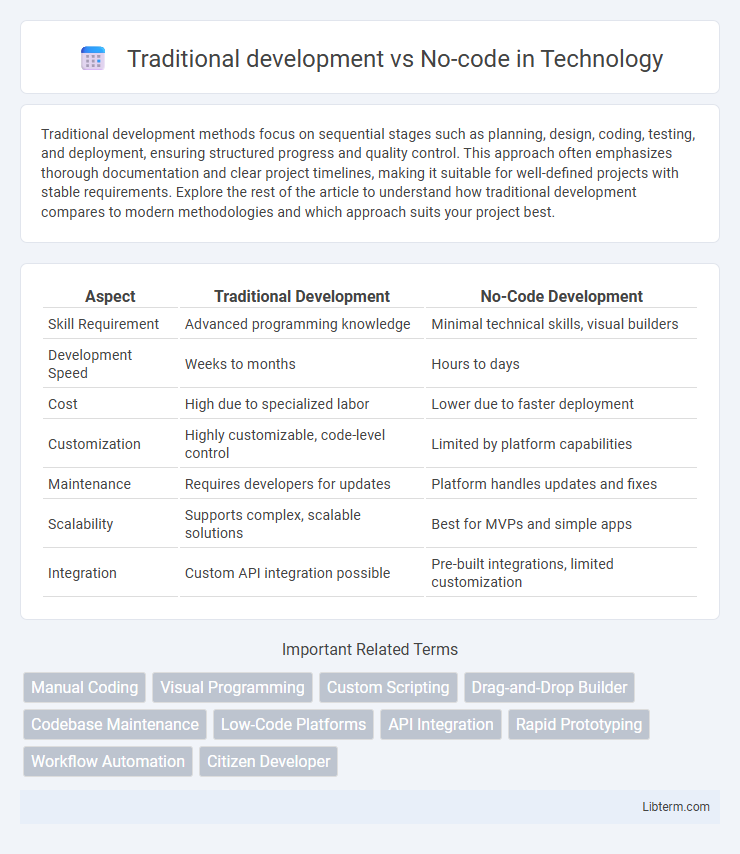Traditional development methods focus on sequential stages such as planning, design, coding, testing, and deployment, ensuring structured progress and quality control. This approach often emphasizes thorough documentation and clear project timelines, making it suitable for well-defined projects with stable requirements. Explore the rest of the article to understand how traditional development compares to modern methodologies and which approach suits your project best.
Table of Comparison
| Aspect | Traditional Development | No-Code Development |
|---|---|---|
| Skill Requirement | Advanced programming knowledge | Minimal technical skills, visual builders |
| Development Speed | Weeks to months | Hours to days |
| Cost | High due to specialized labor | Lower due to faster deployment |
| Customization | Highly customizable, code-level control | Limited by platform capabilities |
| Maintenance | Requires developers for updates | Platform handles updates and fixes |
| Scalability | Supports complex, scalable solutions | Best for MVPs and simple apps |
| Integration | Custom API integration possible | Pre-built integrations, limited customization |
Introduction to Traditional Development and No-Code
Traditional development involves writing custom code using programming languages like Java, Python, or C++, enabling full control over software functionality and scalability. No-code platforms allow users to create applications through visual interfaces without coding, significantly accelerating development time and reducing the need for technical expertise. These contrasting approaches cater to different project requirements, with traditional development suited for complex, highly customized solutions and no-code ideal for rapid prototyping and simple application deployment.
Defining Traditional Development
Traditional development refers to the process of writing custom code using programming languages such as Java, Python, or C++ to create software applications. It involves manually designing, coding, testing, and debugging by professional developers, requiring deep technical expertise and significant time investment. This approach offers high flexibility and control over functionality but generally demands longer development cycles compared to no-code platforms.
Understanding No-Code Platforms
No-code platforms enable users to build applications through visual interfaces and pre-built components, eliminating the need for extensive programming knowledge traditionally required in software development. These platforms accelerate deployment and reduce costs by allowing non-developers to create functional software rapidly. Understanding no-code tools involves recognizing their ability to integrate with existing systems, automate workflows, and provide scalability within a user-friendly environment.
Key Differences Between Traditional and No-Code
Traditional development requires extensive coding skills and longer project timelines, relying on programming languages such as Java, Python, or C#. No-code platforms enable users to build applications through visual interfaces and pre-built components, significantly reducing development time and minimizing technical expertise. Key differences include customization flexibility, scalability, and deployment speed, with traditional development offering greater control and no-code solutions prioritizing accessibility and rapid iteration.
Speed and Efficiency Comparison
The informal sector often lacks legal protections, social security, and minimum wage guarantees, exposing workers to exploitation and poor working conditions. In contrast, the formal sector provides regulated employment with enforced labor laws, social benefits, and access to healthcare and pensions, promoting worker stability and well-being. The disparity significantly impacts social equity, as informal workers face higher vulnerability without formal rights or institutional support.
Cost Implications and Budget Considerations
Traditional development involves higher upfront costs due to expenses in hiring specialized developers, extensive coding, and longer project timelines, often requiring significant budget allocations for maintenance and updates. No-code platforms reduce initial costs by enabling faster deployment and minimizing the need for technical expertise, making them ideal for startups and small businesses with limited budgets. While no-code solutions offer cost-effective scalability, complex enterprise applications may still necessitate traditional development to meet advanced customization and security requirements, impacting overall budget planning.
Flexibility and Customization Capabilities
Traditional development offers unparalleled flexibility and extensive customization capabilities, enabling developers to build tailored solutions that precisely meet complex business requirements through direct access to source code and diverse programming languages. No-code platforms provide rapid application development with user-friendly interfaces, but their customization options are often limited to predefined templates and components, restricting the ability to implement highly specific or unique functionalities. Organizations prioritizing maximum adaptability and intricate feature sets typically favor traditional development, while those seeking faster deployment with moderate customization may opt for no-code solutions.
Scalability and Maintenance
Traditional development offers greater scalability by allowing custom architecture design tailored to specific business needs, enabling long-term growth and complex integrations. No-code platforms simplify maintenance with visual interfaces and pre-built modules, but may face scalability limitations due to platform constraints and reduced control over backend processes. Enterprises prioritizing scalability and extensive maintenance capabilities often prefer traditional development for its flexibility and performance optimization.
Suitable Use Cases for Each Approach
Traditional development suits complex, custom software projects requiring high scalability, performance optimization, and intricate integrations, often used in enterprise environments and large-scale applications. No-code platforms excel in rapid prototyping, small-to-medium business solutions, and non-technical user-driven projects like simple websites, internal tools, and automation workflows. Choosing between traditional and no-code depends on project complexity, development speed, budget constraints, and the need for customization or ongoing maintenance.
Future Trends in Application Development
Future trends in application development highlight a significant shift towards no-code platforms, enabling faster deployment and democratizing app creation for non-technical users. Traditional development remains essential for complex, custom solutions requiring deep programming expertise and scalability. Integration of AI and automation in no-code tools is expected to bridge gaps, enhancing functionality while reducing development cycles and costs.
Traditional development Infographic

 libterm.com
libterm.com